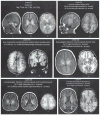Brain injury following trial of hypothermia for neonatal hypoxic-ischaemic encephalopathy
- PMID: 23080477
- PMCID: PMC3722585
- DOI: 10.1136/archdischild-2011-301524
Brain injury following trial of hypothermia for neonatal hypoxic-ischaemic encephalopathy
Erratum in
- Arch Dis Child Fetal Neonatal Ed. 2014 Mar;99(3):301
Abstract
Objective: The objective of our study was to examine the relationship between brain injury and outcome following neonatal hypoxic-ischaemic encephalopathy treated with hypothermia.
Design and patients: Neonatal MRI scans were evaluated in the National Institute of Child Health and Human Development (NICHD) randomised controlled trial of whole-body hypothermia and each infant was categorised based upon the pattern of brain injury on the MRI findings. Brain injury patterns were assessed as a marker of death or disability at 18-22 months of age.
Results: Scans were obtained on 136 of 208 trial participants (65%); 73 in the hypothermia and 63 in the control group. Normal scans were noted in 38 of 73 infants (52%) in the hypothermia group and 22 of 63 infants (35%) in the control group. Infants in the hypothermia group had fewer areas of infarction (12%) compared to infants in the control group (22%). Fifty-one of the 136 infants died or had moderate or severe disability at 18 months. The brain injury pattern correlated with outcome of death or disability and with disability among survivors. Each point increase in the severity of the pattern of brain injury was independently associated with a twofold increase in the odds of death or disability.
Conclusions: Fewer areas of infarction and a trend towards more normal scans were noted in brain MRI following whole-body hypothermia. Presence of the NICHD pattern of brain injury is a marker of death or moderate or severe disability at 18-22 months following hypothermia for neonatal encephalopathy.
Conflict of interest statement
Figures

References
-
- Haataja L, Mercuri E, Guzzetta A, et al. Neurologic examination in infants with hypoxic-ischemic encephalopathy at age 9 to 14 months: use of optimality scores and correlation with magnetic resonance imaging findings. J Pediatr. 2001;138:332–7. - PubMed
-
- Sie LT, van der Knaap MS, Oosting J, et al. MR patterns of hypoxic-ischemic brain damage after prenatal, perinatal or postnatal asphyxia. Neuropediatrics. 2000;31:128–36. - PubMed
-
- Miller SP, Ramaswamy V, Michelson D, et al. Patterns of brain injury in term neonatal encephalopathy. J Pediatr. 2005;146:453–60. - PubMed
-
- Barnett A, Mercuri E, Rutherford M, et al. Neurological and perceptual-motor outcome at 5–6 years of age in children with neonatal encephalopathy: relationship with neonatal brain MRI. Neuropediatrics. 2002;33:242–8. - PubMed
Publication types
MeSH terms
Grants and funding
- U10 HD021385/HD/NICHD NIH HHS/United States
- U10 HD021364/HD/NICHD NIH HHS/United States
- M01 RR008084/RR/NCRR NIH HHS/United States
- UG1 HD027856/HD/NICHD NIH HHS/United States
- U10 HD027851/HD/NICHD NIH HHS/United States
- M01 RR006022/RR/NCRR NIH HHS/United States
- U10 HD027856/HD/NICHD NIH HHS/United States
- U10 HD021373/HD/NICHD NIH HHS/United States
- U10 HD027880/HD/NICHD NIH HHS/United States
- U10 HD040521/HD/NICHD NIH HHS/United States
- U10 HD040461/HD/NICHD NIH HHS/United States
- M01 RR016587/RR/NCRR NIH HHS/United States
- U10 HD040689/HD/NICHD NIH HHS/United States
- U10 HD040492/HD/NICHD NIH HHS/United States
- U10 HD027853/HD/NICHD NIH HHS/United States
- U10 HD027904/HD/NICHD NIH HHS/United States
- U10 HD021397/HD/NICHD NIH HHS/United States
- UL1 TR000454/TR/NCATS NIH HHS/United States
- U10 HD027871/HD/NICHD NIH HHS/United States
- U10 HD034216/HD/NICHD NIH HHS/United States
- U10 HD036790/HD/NICHD NIH HHS/United States
LinkOut - more resources
Full Text Sources
Other Literature Sources
